2012 VOLKSWAGEN GOLF PLUS fuel consumption
[x] Cancel search: fuel consumptionPage 25 of 541
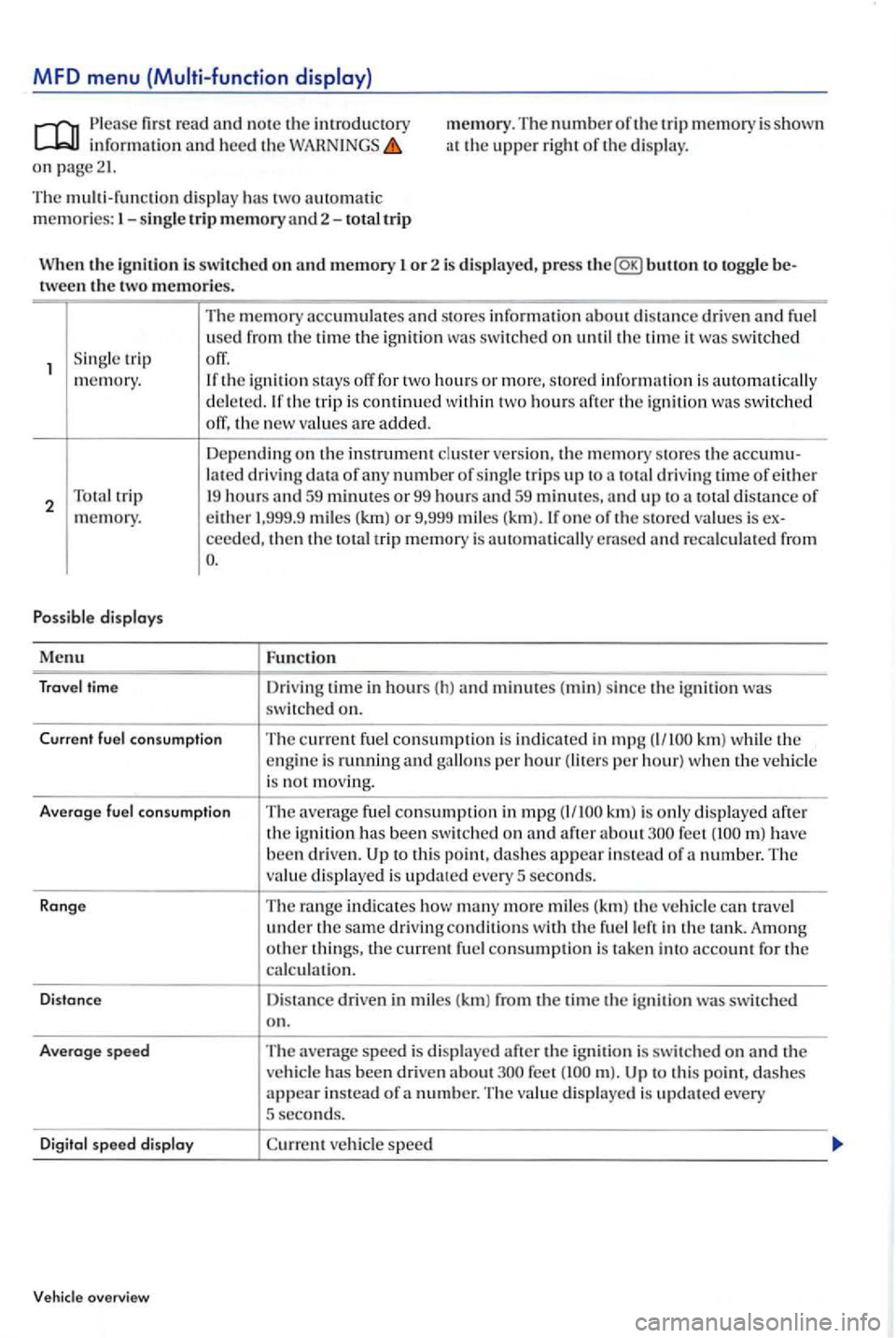
MFD menu
Please first read and not e the introductory information and heed the on page21.
memory. The number of the trip memory is shown at the upper right of th e di splay.
The multi-function displ ay has two automatic memories:
the ignition to toggle tween the two memories.
S in gle trip
memory.
2
s tores information about d istance driven and fuel
u se d from the time the ignition
switched off, the new va lues are added.
Dependin g on the in strument cluster ve rs ion, the m emory stores the lat ed driving data of a ny number of sing le trip s up to total driving time of either 19 hours
ceed ed, then the total trip memory is
Function
Dri ving time in hours ( h) and minutes (min) si nce the ignition was switched on.
Current fuel co nsump tion
The current f u el consumption is indicated in mpg km) the engine is running and per hour) w hen the ve hicle
i s not m ov ing.
Averoge
fuel co nsum ption The average fuel consumption in mpg after about have been driven. to this point, dashes appear in stead of a number. T he
v alu e displayed is update d every 5 seconds.
Ronge
The range indicates how many more mi les (km) the veh icle travel under the same dri ving conditions w ith the fuel
speed is di splayed after the ignition is switched on and the ve hicle has been driven about to thi s po i dashes appear in stead of a n umber. Th e va lue displayed is updated every 5 second s.
D
igit o l speed disploy vehicle speed
Vehicle overview
Page 26 of 541
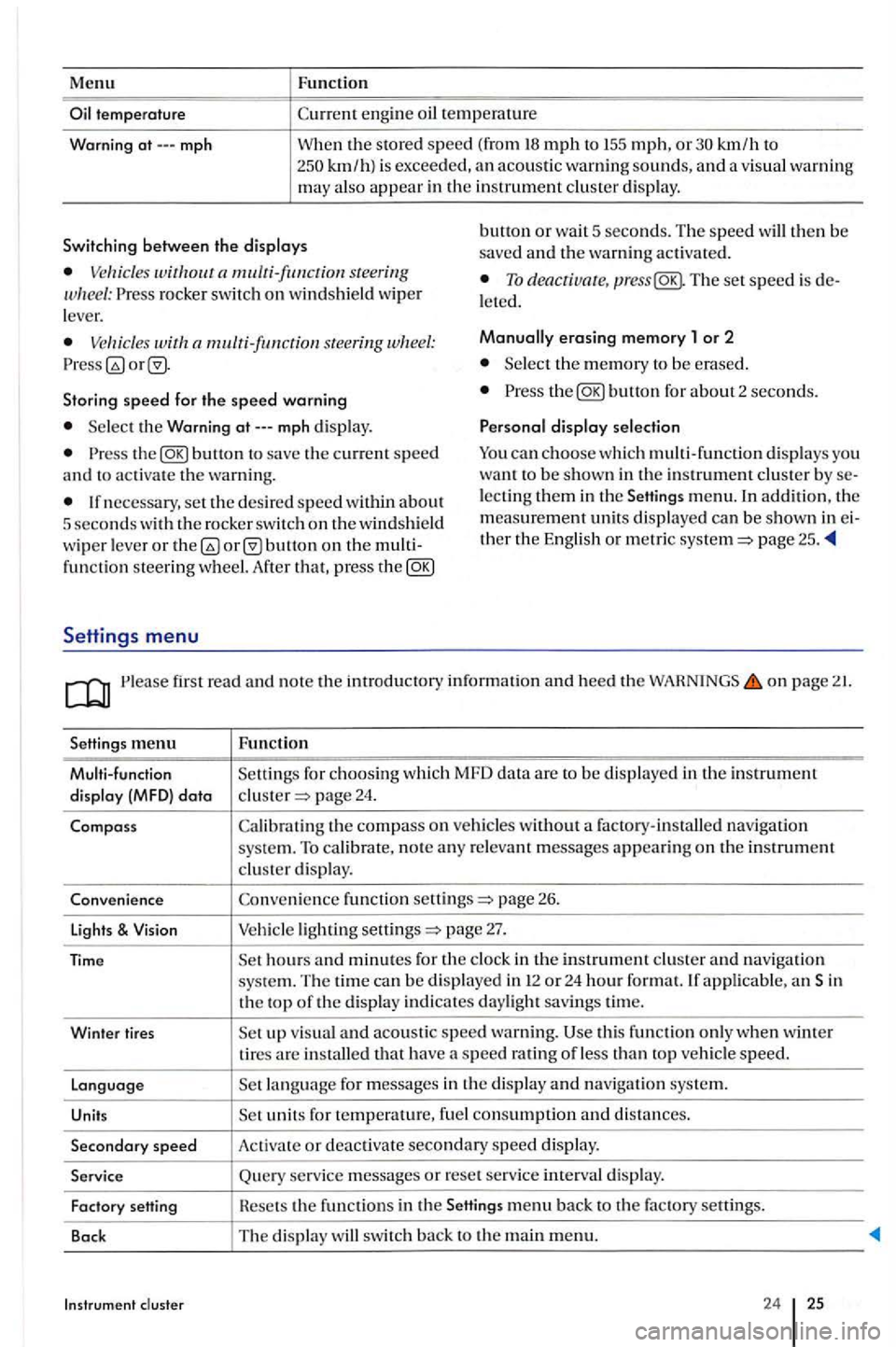
Menu
mph
Function
km/h to km/ h) is exceeded, an acoustic warn ing sounds, and a visua l wa rnin g may also appear in the in strument cluster display.
Switching between th e displays bunon or wa it 5 seconds. The speed will then be
saved and the warning activated.
rocker switch on windshield wip er
l ever. To deacriua re, The set speed is l eted.
s tee rin g Manually erasing memory 1 or 2
Select the m emory to be e rase d.
Storing
speed for the speed warning the
Select the Warning
the
lecting them in the men u. In addition. the
m eas ure m ent units di splayed can be shown in th er the English or metric page 25 .
fun ctio n steering wheel. After that, pres s the
Settings menu
first read and no te the introductory informatio n and heed the WAHNINGS on page
menu Functio n
Multi-function Setting s for c
hoosing whic h MFD data are to be dis play ed in th e in strumen t
di sp lay (MFD) data page 24.
Compass th e compass on ve hicles without a factory-installed navigation system. To calibrate, note any r e levant messages appe a rin g on the in strument cluste r display.
Conveni ence fun ction sellings
page 27.
applicabl e, an Sin
th e top of the d is pla y indicates daylight savings tim e.
Winter tires
visua l and acou st ic speed warning. thi s func tion only when w inter tires are in stalled that have a speed ratin g o f le ss than veh icle speed.
Languag e
units for temperature, fuel consumption and di sta nces.
Secondary speed Activat e or deactiva te secondary speed display.
Service Query se rvice messages or reset se rv ice interva l display.
Fact ory Hesets the funct ions in the
24 25
Page 199 of 541
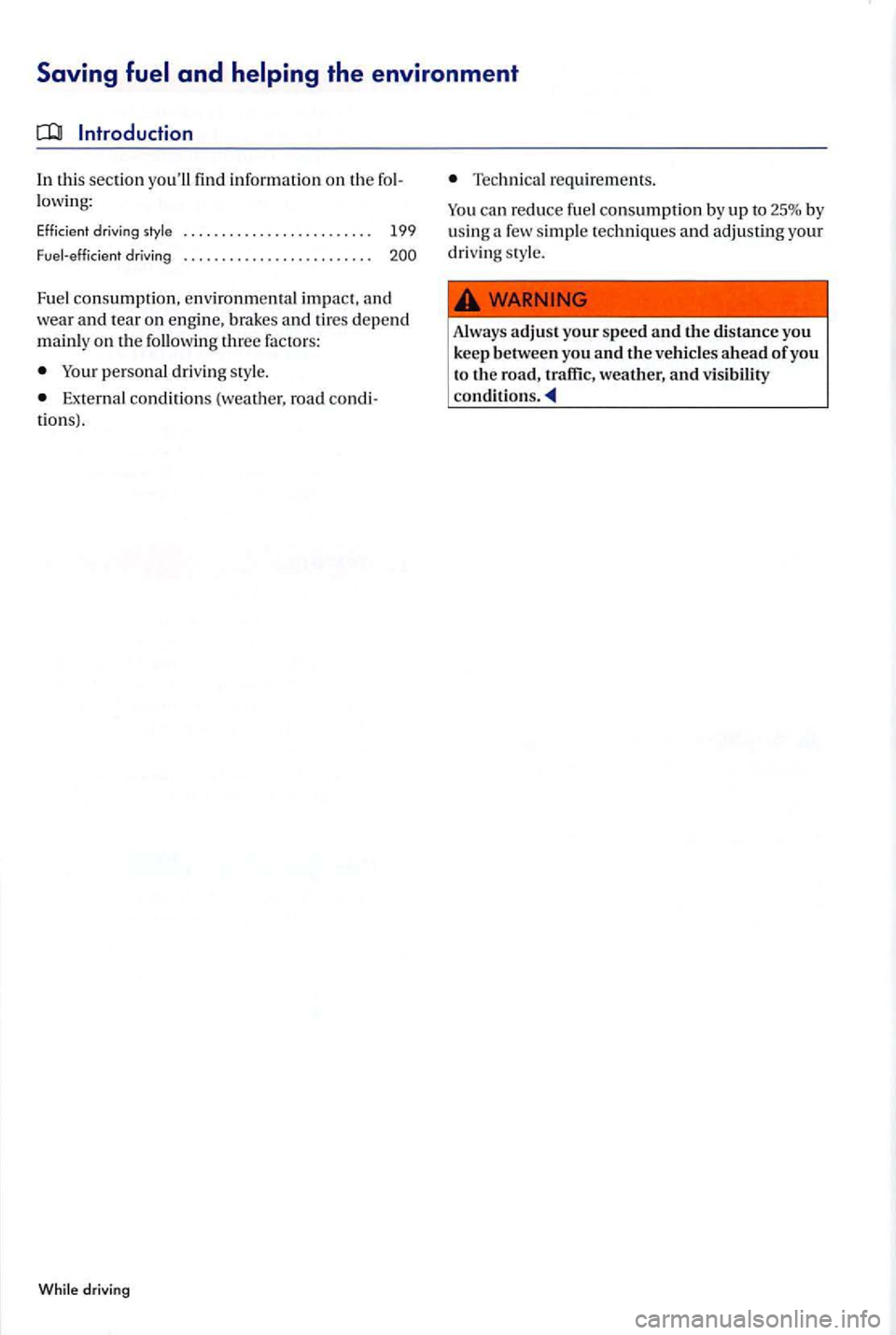
In thi s section yo u'll fin d information on th e lowing:
Effi cient driving style
Fuel-effici ent
driving
199
200
Fue l consumption, environmen ta l impa ct. a nd
wear and tear on engi ne, brak es and tires depend mainly on the following three factor s:
Your personal dri ving style.
Exte rnal condition s (weather, road tio n s).
While driving
Tec hnica l requir ements.
You can reduce fuel consumption by up to 25% by
u sing a few s impl e techniqu es and adjusting you r
driv ing sry le.
Always adjust your speed and the distance you
keep betwee n you and the vehi cles ahead of you to the road,
Page 200 of 541
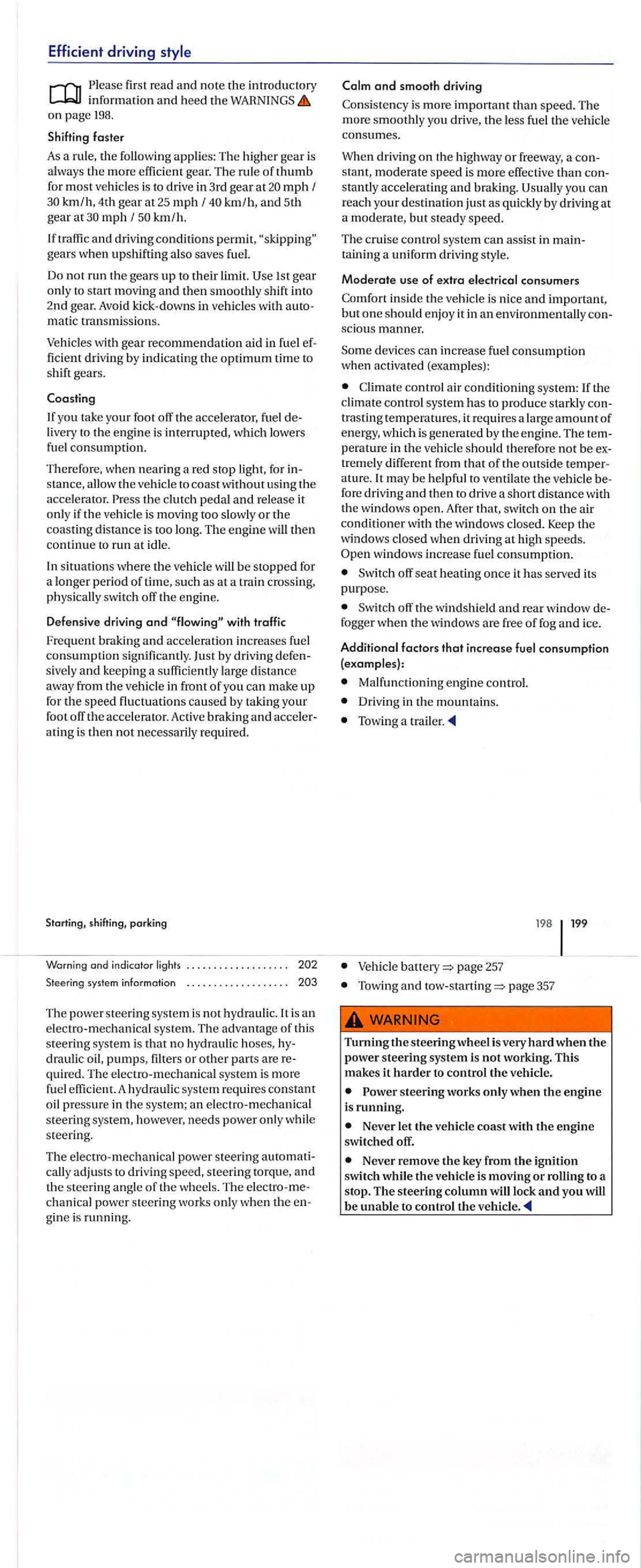
Efficient driving
Please information and heed the on page 198.
Shifting faster
As a rule, the following applies: The higher gear is
a lways the more efficient gear. The rule of thumb for most vehicles is to drive in 3rd gear at mph f km/h, 4th gear at 25 mph f km/h, and 5th gear at mph f km /h.
If
and driving conditions permit, gears when upshifting also saves fuel.
Do
not run the gears up to their limit.
mati c transmissions .
Vehicles with gear recommendation aid in fuel fic ient dri ving by indicating the optimum time to shift gears.
livery to the engine is interrupted, which lowers
fuel consumption.
T herefore, when nearing a red stop light , for s tanc e, allow the vehicle to coast without using the accelera tor. Press the clutch pedal and release it only if the v ehicle is moving too slowly or the coasting distance is too long. The engine will then continue to run at idl e.
In situati ons
where the vehicle will be stopped for
a longer period of time, such as at a train cros sing,
physically switch off the engin e.
D efens ive driving
and with traffic
Fre
quent braking and accel eration increases fuel consumption sign ific antly. Just by driving sivel y and keeping a su fficiently large distance away fro m the vehicle in front of you can make up for the speed fluctuation s caused by taking your foot off the accelerator. Active braking and ating is then not necessarily required.
system information
The power stee ring syste m i s not hydrauli c.lt is an electro-mechanical syste m. The advantage of this
s te ering system is tha t no hydra uli c hoses, draulic oil, pumps, filters or other parts are quired . Th e e lectro-m echanica l system is more fue l effi cient. A hydraulic system requires constant oil pressure in the syste m; an electro -mechanical
s teerin g sys tem, however, needs power only whil e
s teering.
Th e el
ectro-mechanical power steering
chanical power steering works only when the gin e is running.
and smooth driving
Consistency is more important than speed. The more smoothly yo u drive, the less fuel the vehicle consumes.
When driving on the highwa y or freeway, a
stantly accelerating and braking. you can r each your destinatio n just as quickly by driving at a moderate, but steady speed.
The c rui se control syste m can a ssis t in
sciou s manner.
Some dev ices can increase fuel consumption when activated (examples):
C limate control air conditioning system:
trasting temperatures, it requires a large amount of energy, which is generated by the e ngin e. T he
tr emely different from that of the outside
windows increase fuel consumption.
Switch off seat heating once it has served its
purpose.
Sw itch off the windshield and rear window
Malfunctioning engine control.
Driving in the mountains.
Towing a trailer .
page 257
Towing and page 357
Turning the steering wheel is very hard when the power steering system is not working. This makes it harder to control the vehicle.
steering works only when the engine is running.
Never let the vehicle coast with the engine switched off.
Never remove the key from the ignition
switch while the vehicle is moving or rolling to a
stop. The steering column will lock and you will be unable to control the vehicle.
Page 201 of 541
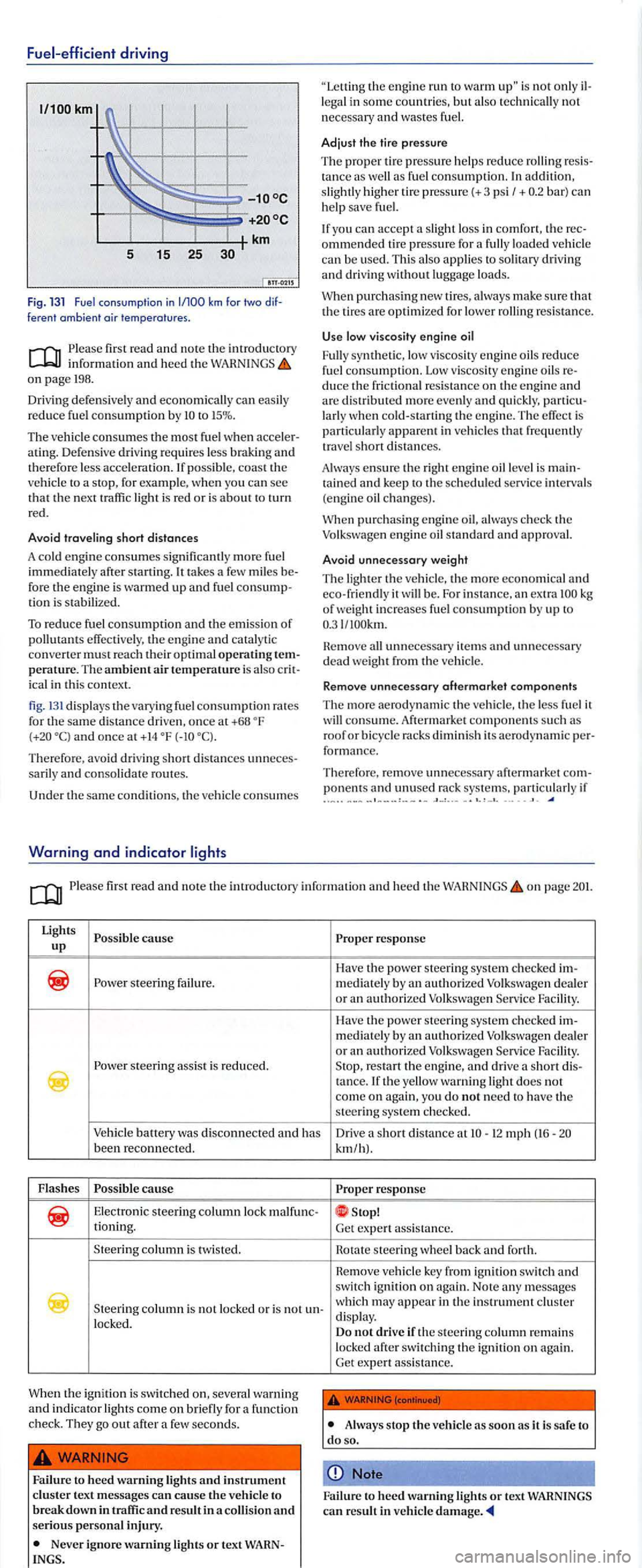
Fuel-efficient driving
Fig. 131 Fuel consumption in ferent ambient air temperatures .
info rmation and heed the on page 198.
Dri vin g defensive ly and economically can easily
r educe fuel con sumption by to 15 % .
The ve hicle consu mes the most fu el w he n atin g. D efe nsive dri vin g require s less brakin g and therefore less accelerat ion. If possib le, coast the ve hicle to a sto p, for exa mple, when yo u ca n see th a t th e next traffic ligh t is red or is about to turn
red.
Avoid traveling short distanc
es
A cold engine consumes sig nificantl y more fuel
imm ediately after sta rtin g. It take s a few miles fore the engi ne is warm ed up and fuel tion i s stabili zed.
To reduce fuel consumptio n and the emission of pollutants effect ive ly, the e ng in e and ca talytic
conve rter must reach th eir optimal operating
ica l in thi s context.
fig. 13 1 displays the v a ry ing fuel consumption rates
for the same d istance dri ven, once at +68 and once at + 14
th e e ngin e run to warm is not o nl y lega l in some co untries, but also technicall y not
n ecessary and wastes fu el.
Adjust the tire pres sure
T he prop er tir e
pressure help s reduce rollin g tance as well as fue l co nsumption. In additi on ,
slig htl y higher tire pressure(+ 3 psi I+ bar) ca n
h e lp save fuel.
If you ca n a ccept a slight los s in comfort, the ommend ed tir e pressure for a fully loade d ve hicl e
ca n be used. This als o applies to so litary dri vin g and driv ing withou t lu ggage loa ds.
When purchasing new t ires, alway s ma ke sure th at
th e tires are optimi zed for lower rollin g resis tance.
Us e low viscosity engine oil
F ull y sy nth e
tic, low viscosity e ngine oils reduce
fuel consumption. Low viscosity e ngin e oils duce the fric tional res istance on th e engine and are dis tributed m ore evenly and qui ckly, larly w hen co ld -s tarting the engine. The effect is parti c ularl y apparent in vehicles th at frequentl y
tra vel s hort dis tan ces.
A lways ens
ure th e righ t e n g in e oil leve l is ta in ed and keep to the sc h edul ed serv ice interva ls
(e ng ine oil ch an ges).
W
hen purch asing e ngine oil, always ch eck th e Volksw agen en gine oil standard and approval.
Avoid unnecessary weight
The lighter th e ve hicl e, th e more economica l and ceo-friend ly it w ill be. For in stance, an extra
H e m ove
consum e. Aftermark et co mponents s uch as
ro of or b icycle racks dimin is h its aerod yn a m ic fonnan ce.
Th erefo re, re
mov e un necessary aftermark e t ponents and unused rac k systems, parti cul arly if ....... -
fir st read and note th e introductory informa tion and h ee d th e WAHNINGS page
response
Ha ve the power stee rin g sys te m ch ec ked ste eri ng failure. mediatel y by an authori zed Volk swag en deale r
o r a n authorized Volk swagen
Fac ility. steeri ng ass is t i s reduced. re start the e n gine, and dri ve a sh ort tan ce. If th e yello w warning light does not
c o m e on again, you do not need to have th e
s te ering syste m ch ec ke d .
Vehicle battery was di sconnected and has Drive a short distan ce at 12 mph been reconnec te d . km/h).
F lashes re sponse
Elec troni c steering column lo ck malfunc -
which m ay appea r in the in strument clu ste r
di sp lay. loc ke d.
W
hen the i g nit ion is switc h ed on, seve ra l wa rnin g and indicator lights come on bri efly for a f un ction ch e ck . T hey go out after a few seconds.
Failure to
heed warning light s and in strument cluster text m essages can cause th e vehicl e to break down in t raffic and result in a collisio n and seriou s personal injury.
Neve r igno re warning lights or tex t
Do not dri ve if th e s teerin g co lumn remains
l ocke d switch in g th e ig niti on on aga in.
Ge t expert assis ta nce.
Alwa ys sto p the vehicl e as soon as it is safe to do so .
Note
Failur e to heed warning lights or tex t WARNINGS can res ult in vehicl e damage
Page 247 of 541
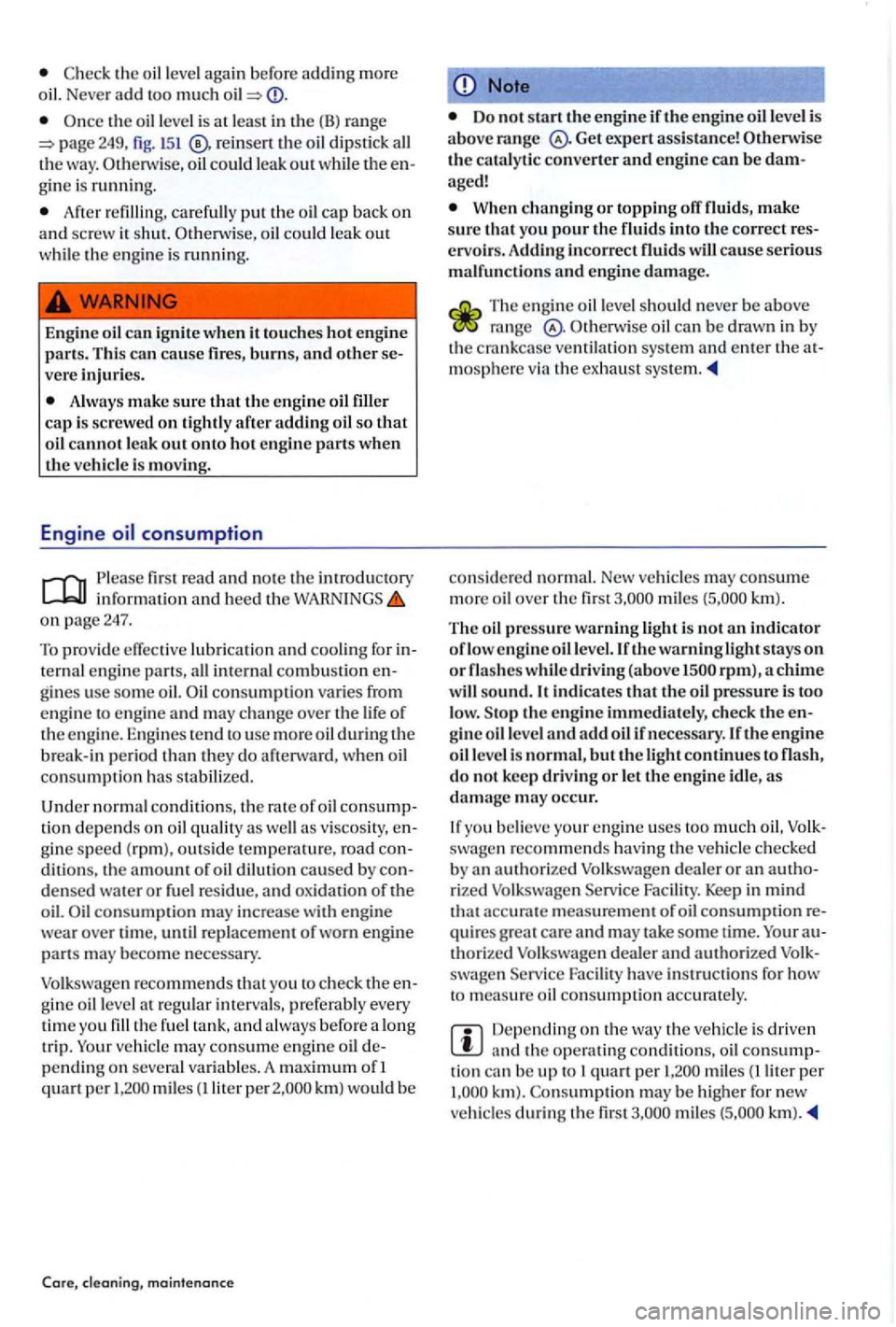
the oil leve l agai n befo re addin g more
oil. Never add much
O nce th e oil leve l is at least in the ( B) ra nge
oil dip stick all th e way. oil could le ak out while th e en
g in e is running.
Afte r r efilling, car efully put the oil ca p back on and scre w it shut. Oth erwi se, oil could leak out whi le th e e ngine is running.
E ngin e oi l ca n ignite
when it tou ches hot e n g ine parts. T hi s can ca use fires, burns, and other severe injuri es.
Always make sure that the engin e oil fill er cap is screwed on tightly afte r adding oil so that oil cannot leak out ont o hot engin e parts whe n
th e vehicle is moving .
Engine
first r ea d and no te th e introductory information and h eed o n pa ge 247.
To prov ide effective lubricatio n and coolin g for in
ternal engine parts, all internal combustio n en
g ines use some oil. consumption varies from
e ng in e to engi ne and may ch an ge ove r th e life of th e e ng in e. Engi nes te nd to use m ore oil during th e
br eak- in peri od th an they do afterwa rd, when oil
co nsumption has s ta bili zed.
rat e of oil consump
tion dep e nd s on oil quality a s well as v isc osity, e n
g in e s pee d (rpm), outs ide tempe rature, road condit io ns, the amount o f oil dilution caused b y condensed water o r fuel residue, and oxidation of th e
o il. consumptio n may in crease with eng in e
wea r ove r time, until re pla cement of worn eng ine part s may beco me necessary .
Volk swage n recommends th at yo u to c heck the engin e oil leve l
vehicl e may consum e engine oil d epending o n seve ral var iables. A maximum of I quart per miles (!lite r km ) would be
Care, maintenance
Note
D o not start the engine if lhe e ngine oil leve l is
above range expert ass is ta n ce! Otl1envise the ca talytic con verter and engine ca n be dam
aged!
W hen changin g or topping ofT make sure that you pour the into the correct reservoir s. Addi ng incorrec t
The e ngine oil leve l s h o uld never be above ran ge oil ca n be drawn in by
th e cra nkcase ventilation syste m and ent er th e at
mo sphere via th e e xh au st sys te m .
co nside red normal. New vehicles may consume
m ore oil over th e km).
T he oi l pressure warning light is not an indicator oflowe ng in e oillevel.lfthe warning light stays on or whil e d rivin g (above rpm), a chime
will sound. It indica tes that the oil pressure is too
low. th e engine immediately, check the engine oil leve l and add oil if n ecessary . If the engine oil leve l is normal , but the continues to do not kee p driving or let t11e e ngin e idl e, as damage may occur.
If you believe your en g in e uses to o much oil, Volkswagen recommends havin g th e vehicle checked b y an auth orized Volkswagen dea le r or an ri ze d Volk swagen Service Facility. Keep in mind that accurate measurem ent of oi l consumption requires great ca re and m ay take som e time. au
t h orized Volkswa gen d ea ler and a uthorized Volk
s wa gen Facility have instru ctions for how to m eas ure oi l co nsumptio n acc ura te ly.
Dep e ndin g on the wa y th e ve hicl e is dri ven an d th e ope ratin g conditions, oil consump
t ion can be up to I quart per mil es (!liter per
Page 475 of 541
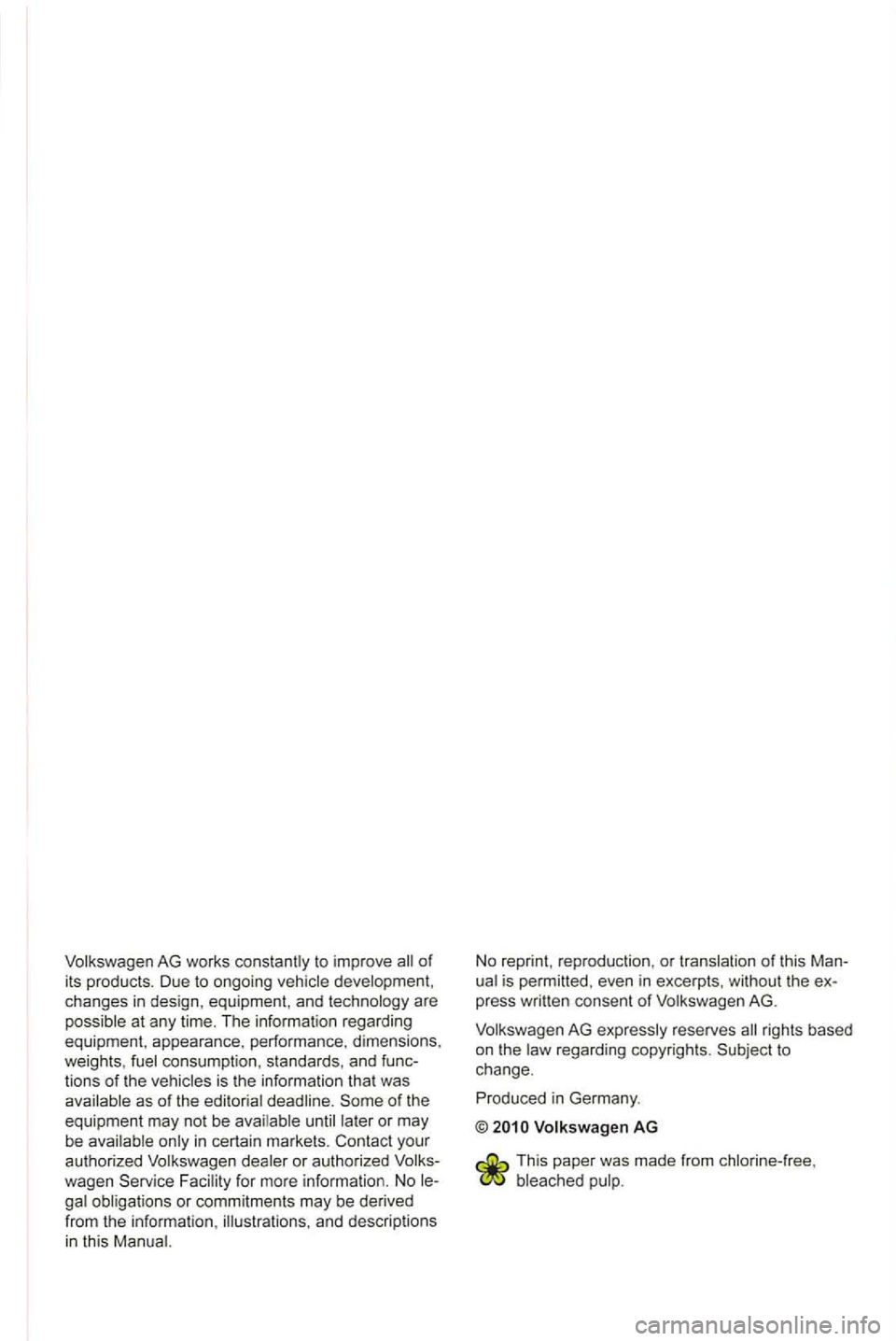
Volkswagen AG works constantly to im pro ve of
its products. Due to o ngoing veh icle development ,
changes
in d esig n, equipment , and techn ology are
possible at any time. The i nform atio n regardi ng
equipment . appea rance. performance, di
mensions .
weights . fuel consumption , standards , a nd functions of the vehicles is the information that was
available as of the editor ia l deadline.
rights based on th e law regarding copyrights. Subject to
c han ge.
Produced in Ger man y.
© Volkswag en AG